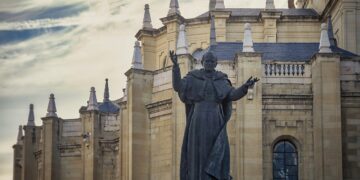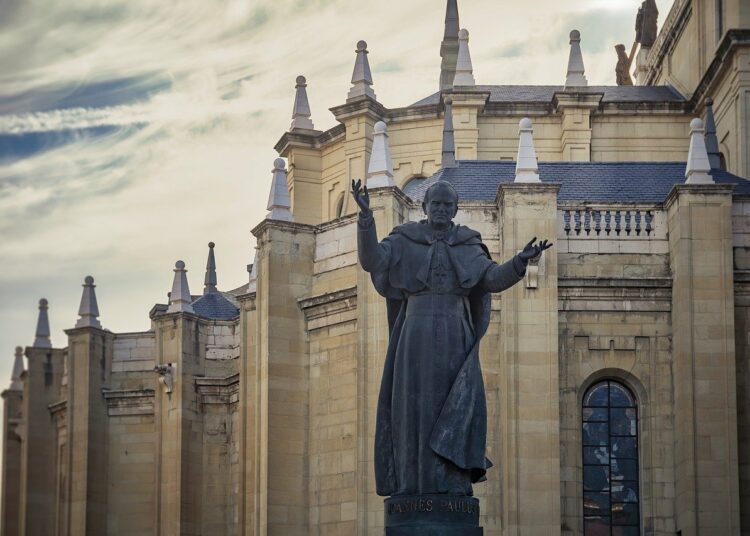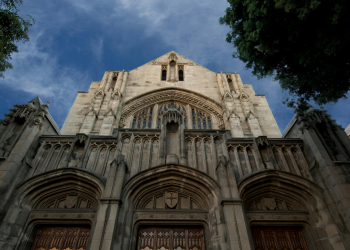In City of Saints, author George Weigel writes of Pope John Paul II’s close relationship with his “beloved Krakow”; the Polish city that the pope called home for 40 years (1938-1978) before he was sent to Rome as the Vicar of Christ. It was in Krakow that Karol Wojtyla (Pope John Paul II) attended university, endured the Nazi occupation of World War II, became a priest, bishop, archbishop and cardinal, and lived under and fought communism. It was here that he received his invaluable training to be the head of the worldwide Catholic Church.
While in the immediate aftermath of Vatican II (1962-65) many dioceses in Europe and North America went into sharp decline (in large part due to the intentional misinterpretation of the Council’s teachings by left-wing clerics and theologians), the diocese of Krakow became stronger than ever under Archbishop Wojtyla. How was Wojtyla able to achieve such success when so much of the rest of the Church in the West began to fall apart? Weigel identifies the seven priorities Wojtyla adopted to strengthen his diocese, priorities that bishops in the West today should study to stem the decline of the Church in America and Europe.
First, Karol Wojtyla made religious freedom the cornerstone of his ministry. To him, religious freedom was the first freedom, the one on which all others depended. Significantly, the defense of religious liberty had a hallowed history in Poland, beginning all the way back in 1079 when a patron saint of Poland, St. Stanislaw, was murdered by King Boleslaw the Bold because the secular ruler thought the Church leader a threat. Weigel writes: “Stanislaw died in defense of the libertas ecclesiae, the freedom of the Church, and in doing so, he died in defense of the moral truth that arbitrary and despotic state power is unjust state power, a threat to the lives and liberties of the people. His twentieth-century successors in the bishop’s chair of Krakow took up the mantle of defensor civitatis against two totalitarian systems, Nazism and communism….” (137) In particular, Wojtyla fought for the right of religious believers to have places to come together to worship and to take their faith outside their churches and into the public square. While the communist authorities were willing to grant a very limited right to worship, they actively stifled the building of new churches and any Church activity outside the walls of a church. As Weigel writes:
“Poland’s communist authorities were determined to reduce Catholicism to a private matter of lifestyle choice; in the battle for the church at Nowa Huta [a “model” communist workers’ town outside of Krakow in which Wojtyla successfully won the right to build a church], and at great public religious events like the annual Corpus Christi procession, Karol Wojtyla met that challenge by demonstrating the inherently public character of Christian faith and the absurdity of a Polish public square stripped of religious conviction.” (176)
Second, Wojtyla strengthened seminary education and stressed continuous education for newer priests. Weigel writes: “In addition to reforming the intellectual preparation of Krakow’s future priests, Wojtyla took their personal and spiritual formation personally, meeting frequently with his seminarians and then holding regular gatherings of each ordination class (sometimes on the ski slopes) during their early years in the priesthood.” (176)
Third, Archbishop Wojtyla made youth ministry a priority. Youth and young people had always been a priority for him ever since he had been a campus minister for two years at the beginning of his priesthood. “The former university chaplain went out of his way to support pastoral initiatives that gave young men and women opportunities for Christian living and Christian formation,” writes Weigel. (176). In addition, through his “Srodowisko”, or “accompaniment”, group, where Wojtyla informally ministered over the decades to hundreds of young people while they went skiing, camping or kayaking together, he came to understand young people and their issues at a more personal level. (He even married several of the participants and baptized their children.) Significantly, Wojtyla did not water down the faith in an effort to be “relevant” to young people; rather, he challenged them to live heroic—and demanding—Christian lives. Weigel writes:
“Unlike those who thought that ‘Catholic Lite’—Catholicism dumbed down doctrinally and morally—was the only possible strategy for youth ministry, the Pope who as a young priest had gotten to know his young friends’ lives ‘from inside,’ through the pastoral method he called ‘accompaniment,’ thought that what young people wanted was challenge and adventure: the challenge and adventure of being more than contemporary youth culture thought they could be; the challenge and adventure of being more than bundles of desires; the challenge and adventure of learning what was right—what made for true happiness—and then conforming their lives to that.” (160-61)
Fourth, Wojtyla made marriage and family ministry a priority. “The young priest-philosopher who had made marriage preparation a key part of his ministry to his Srodowisko and others now created Poland’s first diocesan institute on marriage and the family…and made training for marriage preparation an essential part of the formation of seminarians and the ongoing education of priests,” writes Weigel. (177) In addition, he also started a Church fund for unwed mothers who wished to keep their children and urged local convents to support these women while pregnant and until they were able to live on their own.
“A man of constant conversation, Karol Wojtyla made ongoing dialogue with the academics and intellectuals of Krakow the fifth priority of his ministry as archbishop,” states Weigel. (175) Significantly, in addition to reaching out to Catholic intellectuals, he made sure to include secular ones in his group as well. Indeed, this bringing together of both religious and secular scholars helped to “lay some of the foundations of the broad-based Solidarity movement of the future.” (178)
Sixth, the archbishop made charity a focus of his diocese. While the communist government forbade formal Catholic charitable institutions, Wojtyla worked around this by creating “pastoral charity teams” that would care for the sick and destitute. He also made it a priority to bring the sick and elderly, two overlooked groups in communist society, into the life of the Church.
Lastly, Wojtyla made regular visits to the parishes in his diocese a priority. During these trips, “he would often move into a local community for days, sharing its life, blessing new graves, offering a special Mass and blessing for married couples, celebrating the sacrament of Confirmation, meeting with the local sisters and lay volunteers, and devoting special attention to the parish religious teachers.” (178) Like with his Srodowisko group for young people, he made “accompaniment” something that permeated everything he did.
In his book City of Saints: A Pilgrimage to John Paul II’s Krakow, George Weigel writes about how Archbishop Karol Wojtyla, the future Pope John Paul II, was able to strengthen his diocese at a time when many other dioceses in the West were beginning to die. Significantly, by fighting for the role of believers in the public square, strengthening the education of seminarians and young priests, making youth, marriage, and family ministries a priority, engaging with intellectuals within and outside of the Church, and spending more time getting to know their parishes, bishops in America and Europe today could learn from Karol Wojtyla and revitalize many of their moribund dioceses.




















Discussion about this post